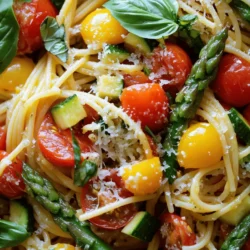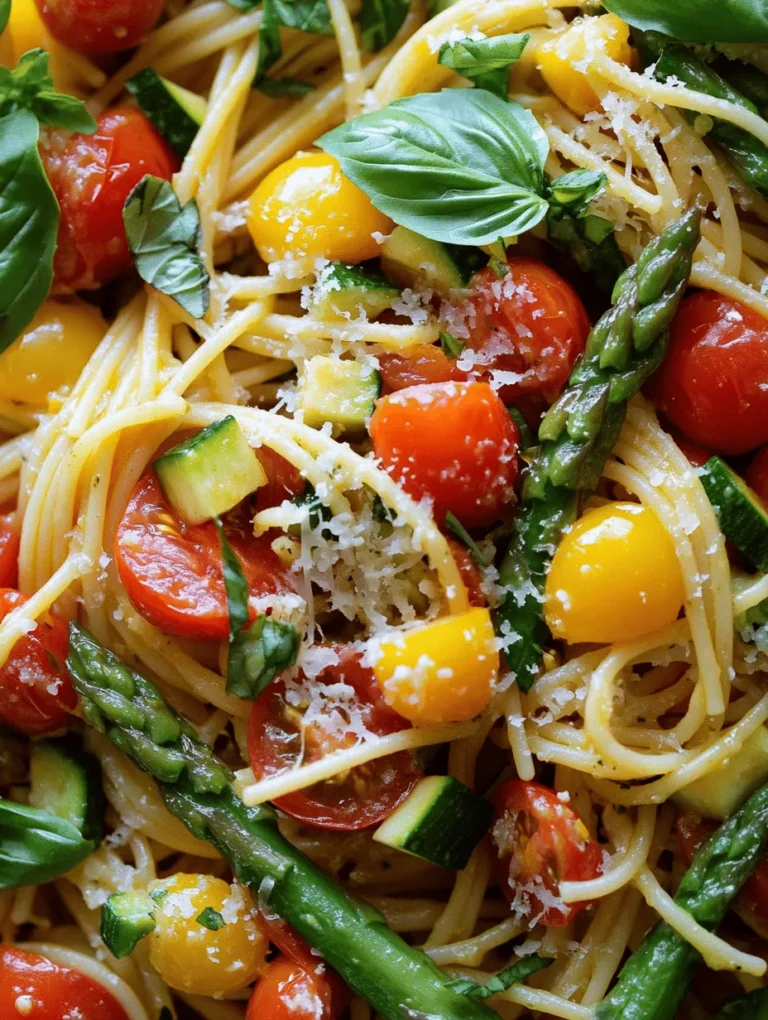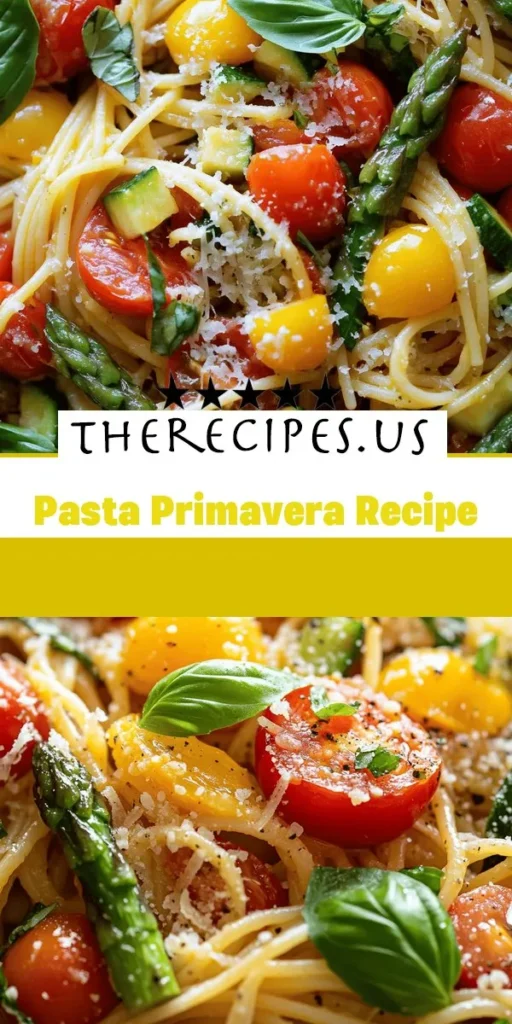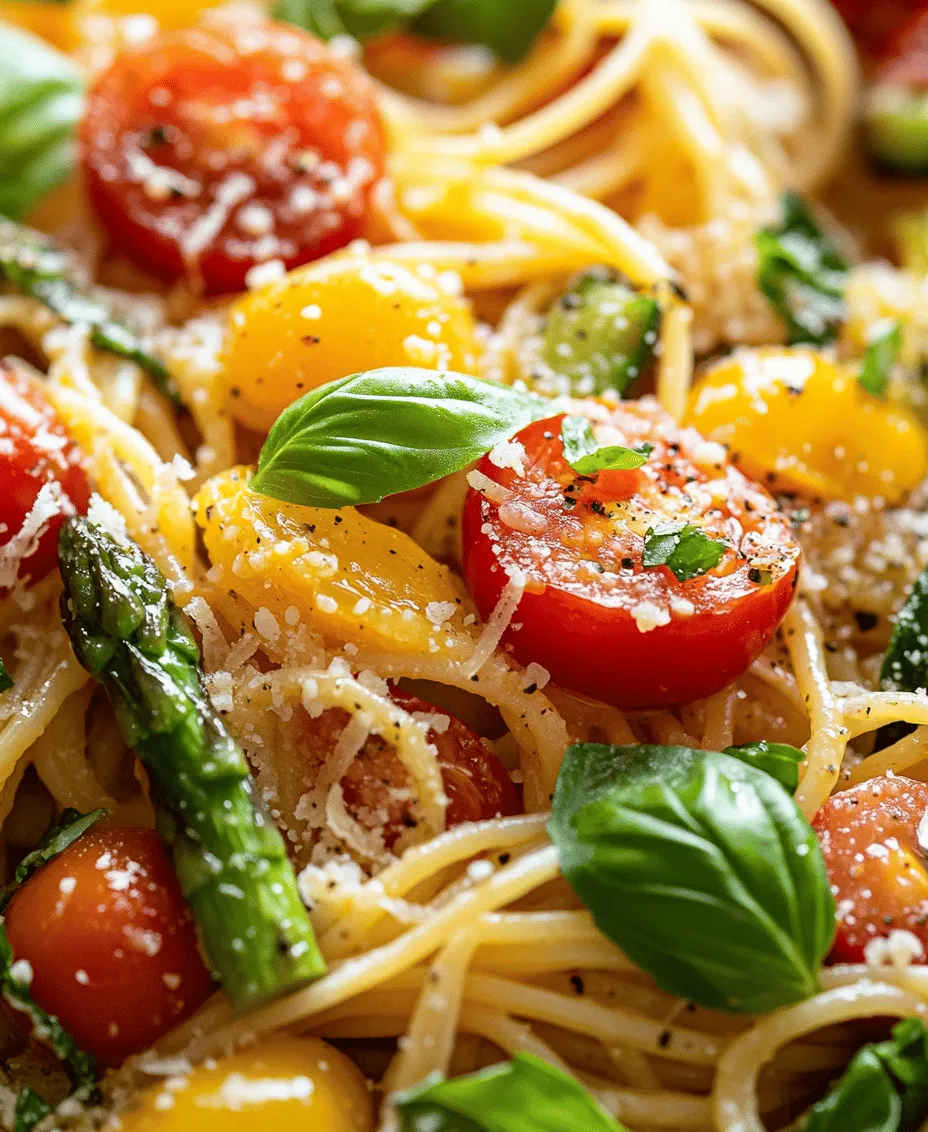In the world of Italian cuisine, few dishes encapsulate the spirit of fresh, seasonal vegetables quite like Pasta Primavera. This vibrant and colorful dish not only delights the palate but also provides a healthy balance of flavors and textures. The Pasta Primavera Delight recipe combines al dente fettuccine with a medley of sautéed vegetables, infused with aromatic garlic and herbs, and finished with a sprinkle of Parmesan cheese. In this article, we will explore the intricacies of this delightful recipe, its history, variations, and tips for making the best Pasta Primavera at home.
The Essence of Pasta Primavera
Understanding the roots of Pasta Primavera can enhance your appreciation for this dish. Historically, this classic Italian pasta dish emerged in the mid-20th century, known for its fresh vegetables that celebrate spring. The term “primavera” translates to “spring” in Italian, signifying the use of seasonal produce. As a dish, it reflects the philosophy of Italian cooking, which emphasizes simplicity and the use of high-quality, fresh ingredients.
Pasta Primavera is versatile, allowing for creativity in ingredient choices and variations based on seasonal availability. Whether you’re enjoying it in the heart of spring or adapting it for the cooler months, the essence of this dish remains rooted in the celebration of vegetables and pasta as a harmonious duo.
Ingredients Breakdown
Examining the ingredients can help home cooks understand the role of each component in creating a balanced dish.
Pasta Selection
When it comes to creating the perfect Pasta Primavera, the choice of pasta is crucial. Fettuccine is often favored for its flat, wide shape, which allows it to hold onto the sauce and the sautéed vegetables better than thinner pasta types, such as spaghetti or angel hair. The texture of fettuccine offers a satisfying bite, complementing the crunch of the vegetables beautifully. However, feel free to experiment with other pasta types, such as penne or farfalle, according to your preference.
Vegetable Variety
One of the standout features of Pasta Primavera is its vibrant array of vegetables, each contributing unique flavors and nutritional benefits. Key ingredients typically include:
– Zucchini: This summer squash is low in calories but rich in vitamins A and C, making it an excellent addition for both flavor and nutrition.
– Yellow Squash: Similar to zucchini, yellow squash adds a delightful sweetness and a pop of color to the dish.
– Red Bell Pepper: Known for its crisp texture and sweet flavor, red bell pepper is high in antioxidants and vitamin C, providing a refreshing crunch.
– Cherry Tomatoes: These bite-sized gems burst with flavor when sautéed, adding a juicy element to the dish that enhances its overall taste.
– Broccoli: Packed with vitamins K and C, broccoli not only adds nutritional value but also brings a delightful crunch and a beautiful green hue to the plate.
Herbs and Spices
The role of herbs and spices in Pasta Primavera cannot be overstated. Aromatic garlic serves as the base flavor, creating an inviting aroma and depth of taste. Fresh or dried oregano complements the dish with its earthy notes. For those who enjoy a bit of heat, optional red pepper flakes can be added to elevate the flavor profile, providing a delightful kick.
Cheese Choice
Freshly grated Parmesan cheese is essential for finishing this dish. Its nutty, salty flavor enhances the overall taste and adds a creamy texture when combined with the sautéed vegetables and pasta. Opting for high-quality cheese, preferably aged, will yield the best results. If you’re looking for a dairy-free alternative, nutritional yeast can be a great substitute, providing a cheesy flavor without the dairy.
Olive Oil
The choice of oil used in cooking can significantly impact the flavor of your Pasta Primavera. High-quality extra virgin olive oil is recommended for sautéing the vegetables, as it adds richness and enhances the dish’s overall flavor profile. Olive oil is also known for its heart-healthy benefits, making it a perfect choice for this wholesome meal.
Step-by-Step Preparation of Pasta Primavera Delight
This section will provide a detailed breakdown of the cooking process, ensuring readers can recreate the dish effortlessly.
Cooking the Fettuccine
To start, bring a large pot of salted water to a boil. Adding salt is crucial as it infuses the pasta with flavor. Once the water is boiling, add the fettuccine and cook according to the package instructions until it reaches an al dente texture. This means it should be firm to the bite but cooked through. Remember to reserve about a cup of the pasta water before draining, as this starchy water can be used later to adjust the sauce’s consistency.
Sautéing Vegetables
While the pasta cooks, it’s the perfect time to sauté the vegetables. In a large skillet, heat a generous drizzle of extra virgin olive oil over medium heat. Once the oil is shimmering, begin by adding the vegetables that take longer to cook first. Start with the broccoli florets and red bell pepper, stirring occasionally for about 3-4 minutes until they begin to soften.
Next, add in the zucchini and yellow squash, cooking for an additional 2-3 minutes. Finally, toss in the cherry tomatoes and cook just until they start to burst, approximately 2 minutes. This method ensures that each vegetable retains its unique texture and flavor, contributing to the overall dish’s vibrancy.
Incorporating Garlic and Seasoning
Timing is crucial when it comes to adding garlic. After the vegetables have softened but before they reach full tenderness, add minced garlic to the skillet. Sauté it for about 30 seconds until it becomes fragrant—be careful not to let it burn, as burnt garlic can impart a bitter taste to the dish. Once the garlic is aromatic, season the vegetables with salt, pepper, and oregano. This step helps to bring out the natural flavors of the vegetables while also enhancing the dish’s seasoning.
Mixing Pasta with Vegetables
After the fettuccine has been cooked and drained, it’s time to bring everything together. Add the pasta directly into the skillet with the sautéed vegetables, tossing gently to combine. If the mixture seems too dry, gradually add reserved pasta water a little at a time until you reach your desired consistency. This starchy water will help bind the pasta and vegetables together, creating a cohesive dish that’s both flavorful and satisfying.
In this vibrant Pasta Primavera Delight, the combination of fresh vegetables, aromatic herbs, and perfectly cooked fettuccine creates a dish that not only looks beautiful but also tastes incredible. As we continue with the next section, we will explore tips for achieving the best results and answer some common questions about this delightful recipe.
Finishing Touches
Once your Pasta Primavera is perfectly cooked and the vibrant vegetables are tender yet crisp, it’s time to add those final touches that will elevate your dish. Begin by incorporating the cheese, which adds a creamy richness to your pasta. Choose a cheese that melts beautifully, such as freshly grated Parmesan or Pecorino Romano.
To incorporate the cheese, simply sprinkle it over the pasta while it’s still warm. Toss gently to allow the heat from the pasta to melt the cheese, creating a luxurious coating that clings to each strand. Be generous, but remember that a little goes a long way.
Next, garnish your dish with fresh basil leaves. Not only do they add a pop of color, but they also contribute a fragrant aroma that enhances the overall flavor profile. Tear the basil leaves by hand to release their essential oils, and sprinkle them over the top just before serving. This step not only makes your dish visually appealing but also brings a burst of fresh flavor that beautifully complements the sautéed vegetables.
Nutritional Value of Pasta Primavera
Pasta Primavera is not only a feast for the eyes but also a nutritious choice for those looking to maintain a balanced diet. This dish is packed with essential nutrients, making it a great addition to your meal rotation.
Caloric Breakdown
A standard serving of Pasta Primavera typically contains around 350-450 calories, depending on the specific ingredients and portion sizes. This makes it suitable for various dietary plans, whether you’re aiming for weight loss, maintenance, or simply looking to eat healthier. The combination of carbohydrates from the pasta and the fiber from the vegetables provides sustained energy, making it a wonderful choice for lunch or dinner.
Vitamins and Minerals
The vegetables in Pasta Primavera are the stars of the show and provide an array of vitamins and minerals. Bell peppers, zucchini, broccoli, and carrots are particularly rich in vitamins A and C, which are essential for maintaining healthy vision, skin, and immune function. Additionally, many of these vegetables contain potassium, which is vital for heart health and muscle function.
By incorporating a variety of colorful vegetables, you ensure a broader spectrum of nutrients, allowing your body to benefit from different vitamins and minerals while enjoying a delicious meal.
Dietary Fiber
One of the standout features of Pasta Primavera is its high dietary fiber content. The fiber found in vegetables is crucial for digestive health, helping to maintain regularity and prevent constipation. Furthermore, fiber can aid in weight management by promoting a feeling of fullness, which can help control hunger and reduce overall calorie intake. Each serving of Pasta Primavera can provide you with a significant portion of your daily fiber needs, making it an excellent choice for those looking to boost their fiber intake.
Variations and Adaptations of Pasta Primavera
The beauty of Pasta Primavera lies in its versatility. This dish can easily be adapted to suit different tastes, dietary restrictions, or seasonal availability of ingredients. Here are several ideas to personalize your Pasta Primavera experience.
Vegetable Swaps
Feel free to get creative with the vegetables you include in your Pasta Primavera. Depending on the season, you might consider using asparagus, snap peas, or cherry tomatoes. These additions not only bring unique flavors but also a range of colors that enhance the dish’s visual appeal. Experimenting with vegetables allows you to keep the dish fresh and exciting, making it a new experience each time you prepare it.
Protein Additions
For those looking to elevate their dish to a heartier meal, consider adding a source of protein. Grilled chicken, shrimp, or even chickpeas can be fantastic additions. Chicken can be sautéed alongside the vegetables, while shrimp cooks quickly, making it a great last-minute addition. For a vegetarian option, chickpeas add texture and protein without compromising the dish’s integrity. Simply toss them in with the pasta to heat through.
Dairy-Free Options
If you’re accommodating dairy-free diets, there are plenty of alternatives to traditional cheese. Nutritional yeast can be sprinkled on top for a cheesy flavor without the dairy, or you might consider using cashew cheese or a store-bought dairy-free cheese alternative. These options allow you to enjoy the creamy aspect of the dish while adhering to dietary needs.
Gluten-Free Alternatives
For those who are gluten-sensitive or following a gluten-free diet, there are numerous pasta options available today. Look for gluten-free pasta made from brown rice, quinoa, or lentils. These alternatives not only maintain the essence of pasta but also add additional nutrients. Ensure you follow the cooking instructions for these alternatives, as they may vary from traditional wheat pasta.
Serving Suggestions for Pasta Primavera Delight
Presentation plays a crucial role in culinary enjoyment. Here are some serving suggestions to help you plate your Pasta Primavera beautifully and complement it with delightful pairings.
Ideal Pairings
Pasta Primavera can be enjoyed on its own, but pairing it with complementary side dishes can enhance your meal. Garlic bread is a classic accompaniment that adds a satisfying crunch and flavor. A fresh salad, perhaps with mixed greens, cherry tomatoes, and a light vinaigrette, can provide a refreshing counterpoint to the warm pasta.
For a heartier option, consider serving it alongside roasted vegetables or a protein like grilled chicken or fish. These pairings not only round out the meal but also ensure a well-balanced plate.
Presentation Ideas
To impress your family or guests, consider how you plate your Pasta Primavera. Start by twirling the pasta into a nest-like shape in the center of the plate. Arrange the sautéed vegetables artfully around the pasta heap, creating a colorful display. Drizzle a little extra virgin olive oil over the top and finish with a generous sprinkle of grated cheese and a scattering of freshly torn basil for that vibrant touch.
Using colorful plates can enhance the visual appeal, making the dish pop even more. Remember, we eat with our eyes first, so take the time to make your dish as appealing as it is delicious.
Conclusion: Enjoying Your Pasta Primavera Delight
Pasta Primavera Delight is more than just a recipe; it embodies the essence of fresh, wholesome cooking, celebrating the vibrant flavors of seasonal vegetables. This dish is not only a visual feast but also a nutritional powerhouse, making it a perfect addition to any meal.
By mastering the simple preparation techniques and understanding the versatility of this dish, you can create a delightful culinary experience that is both satisfying and healthy. Whether you enjoy it as a main course or as a side dish, Pasta Primavera is sure to become a staple in your kitchen.
Embrace the spirit of spring with each delicious bite of Pasta Primavera Delight, and let this recipe inspire you to explore the world of fresh vegetables and vibrant flavors in your cooking endeavors. Enjoy the journey and the delightful meals that come with it!



